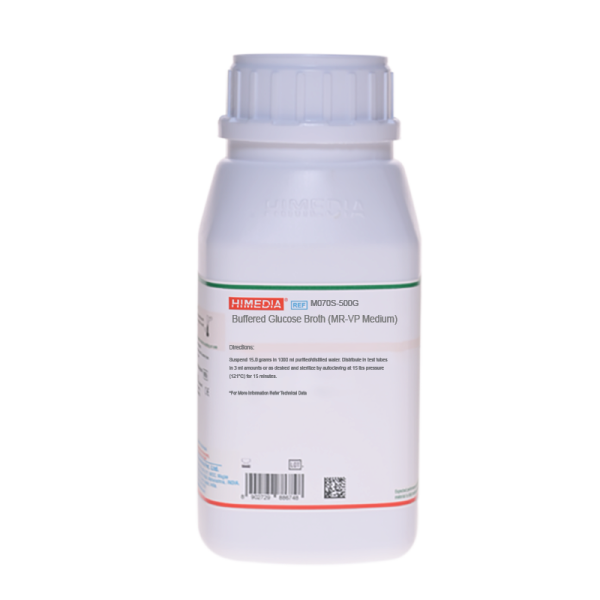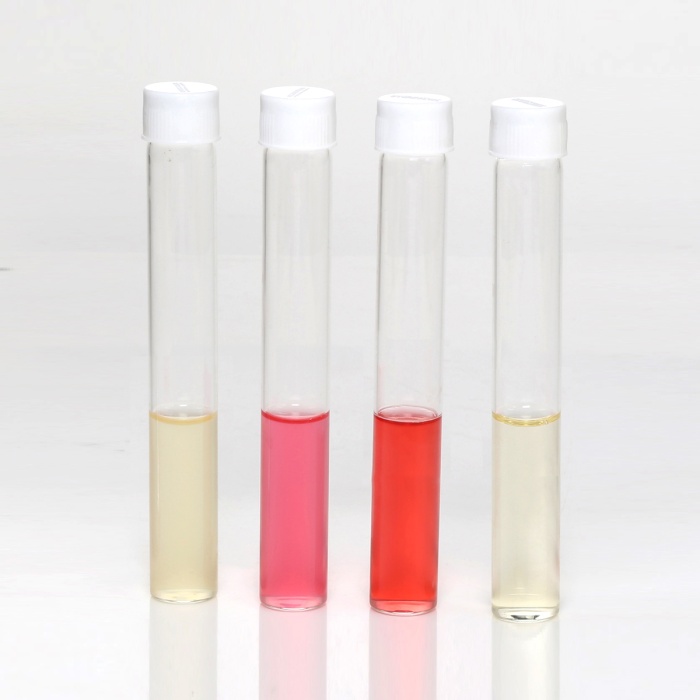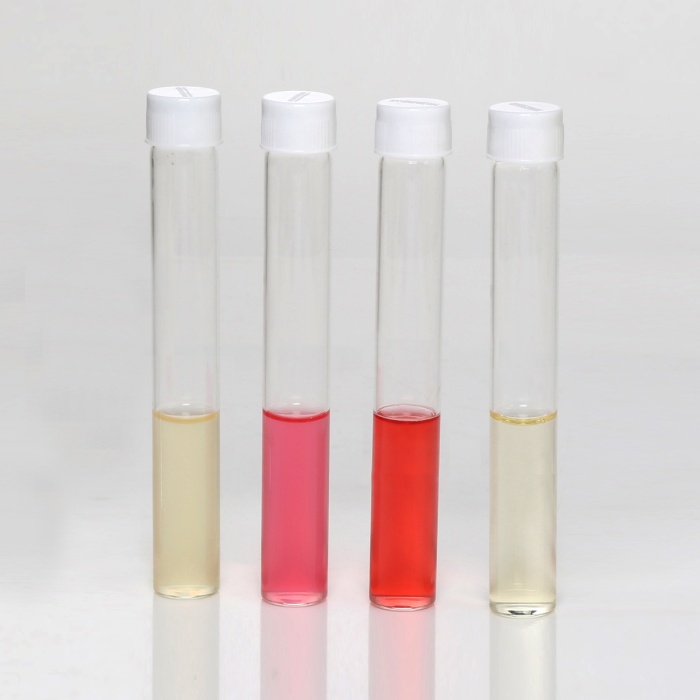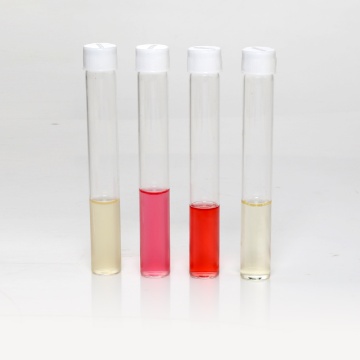 Your enquiry has been submitted
Your enquiry has been submitted
Buffered Glucose Broth
MR-VP Medium (Glucose Phosphate Broth) is recommended for studying Methyl Red and Voges-Proskauer tests to differentiation amongst coli-aerogenes group.
Composition**
| Ingredients | Gms / Litre |
|---|---|
| Peptic digest of animal tissue | 5.000 |
| Dextrose | 5.000 |
| Dipotassium phosphate | 5.000 |
| Final pH (at 25°C) | 7.5±0.1 |
**Formula adjusted, standardized to suit performance parameters
Directions
Suspend 15 grams in 1000 ml of distilled water. Distribute in test tubes in 3 ml amounts or as desired and sterilize by autoclaving at 15 lbs pressure (121°C) for 15 minutes.
Principle And Interpretation
Clark and Lubs (1) found that the addition of methyl red to cultures of Escherichia coli resulted in a red colour due to high acidity produced during dextrose fermentation. Voges-Proskauer (2) reported red colouration after addition of potassium hydroxide to specific culture media with organisms grown in it. The investigators developed MR-VP Broth which enables both tests to be performed in same medium in different tubes. The red colour produced by the addition of potassium hydroxide to cultures is due to the ability of organisms to produce a neutral product acetoin (acetyl methyl carbinol) from dextrose (3). The acetoin is oxidized in the presence of oxygen and alkali to produce diacetyl which reacts with creatine to produce a red colour. This formulation is also recommended by BIS (5) and ISO committee (8) for the detection of coli-aerogenes group. A slightly modified formulation (M070S) is recommended by BIS (4,6,7) for the detection of E. coli, Vibrio parahaemolyticus and Bacillus cereus responsible for food poisoning. To test V.parahaemolyticus for VP, addition of 2-3% Sodium chloride to the medium is required.
The Methyl Red (MR) test is performed after maximum of 5 days of incubation at 30°C (9) and Voges-Proskauer test (VP) cultures are incubated at 30°C for 24-48 hours (10). Various other tests have been suggested by Werkman (11), OMeara (12) Levine, Epstein and Voughn (13) and Voughn, Mitchell and Levine (9). Werkmans Test (8): Add 2 drops of a 2% solution of ferric chloride to 50 ml culture and 5 ml of 10% sodium hydroxide. Shake the tube to mix well. Stable copper colour developing in a few minutes is positive reaction. OMeara Test (8): Add of 25 mg of solid creatine to 5ml culture and then add 5 ml concentrated (40%) sodium hydroxide. Red colour development in a few minutes after shaking the tube well, is a positive reaction. Levine, Epstein and Voughn (13) modified OMeara technique by dissolving the creatine in a concentrated solution of potassium hydroxide. Voughn, Mitchell and Levine (9) recommended the method of Barritt (14) as, addition of 1 ml of 40% potassium hydroxide and 3 ml of 5% a - naphthol in absolute ethanol to 5 ml culture. Positive test is indicated by eosine pink colour within 2-5 minutes.
Quality Control
Appearance: Cream coloured homogeneous free flowing powder
Colour and Clarity of prepared medium: Light yellow coloured clear solution without any precipitate.
Reaction: Reaction of 1.5% w/v aqueous solution at 25°C. pH: 7.5±0.1
pH: 7.40-7.60
Cultural Response
M070S: Cultural characteristics observed after an incubation at 30°C for 48 hours.
| Organism | Inoculum (CFU) | Growth | MR Test | VP Test |
|---|---|---|---|---|
| Bacillus cereus ATCC 10876 | 50-100 | luxuriant | Negative colour | Positive reaction, yellowreaction, eosin pink / red colour within 2-5 minutes |
| Enterobacter aerogenes ATCC 13048 | 50-100 | luxuriant | Negative colour | Positive reaction, yellowreaction, eosin pink / red colour within 2-5 minutes |
| Escherichia coli ATCC 25922 | 50-100 | luxuriant | Positive red colour | Negative reaction, no colour change |
| Klebsiella pneumoniae ATCC 23357 | 50-100 | luxuriant | Negative colour | Positive reaction, yellowreaction, eosin pink / red colour within 2-5 minutes |
| Salmonella Typhi ATCC 6539 | 50-100 | luxuriant | Positive red colour | Negative reaction, no colour change |
| Vibrio parahaemolyticus ATCC 17802 | 50-100 | poor | Negative reaction, yellow colour | Negative reaction, no colour change |
Storage and Shelf Life
Store below 30°C in tightly closed containers and the prepared medium at 2 - 8°C. Use before expiry date on the label.
Reference
- Clark and Lubs, 1915, J. Inf. Dis., 17 : 160.
- Voges and Proskauer, 1898, Zeit, Hyg., 28: 20.,,
- MacFaddin, J.F., 1985, Media for Isolation-Cultivation-Identification-Maintenance of Medical Bacteria, Vol. 1, Williams and Wilkins, Baltimore.
- Bureau of Indian Standards, IS : 5887 (Part I) 1976, reaffirmed 1986.
- Bureau of Indian Standards, IS: 5887 (Part - III) 1976.
- Bureau of Indian Standards, IS: 5887 (Part IV) 1976.
- Bureau of Indian Standards, IS: 5887 (Part - V) 1976, reaffirmed 1986.
- International Organization for Standardization (ISO), 1993, Draft ISO/DIS 6597.
- Vaughn, Mitchell and Levine, 1939, J. Am. Water Works Association, 31:993.
- Kallas, Chinn and Coulter, 1931, J. Bact., 22: 125.
- Werkman, 1930, J. Bact., 20 : 121.
- OMeara, 1931, J. Path. Bacteriol., 34 : 401.
- Levine, Epstein and Voughn, 1934, Am. J. of Publ. Health, 24: 505.
- Barritt, 1936, J. Path. Bacteriol., 42: 441.
| Product Name | Buffered Glucose Broth |
|---|---|
| SKU | M070S |
| Product Type | Regular |
| Physical Form | Powder |
| Origin | Animal |
| Packaging type | HDPE |
| References | 1.Voges O. and Proskauer B., 1898, Z. Hyg. Infektionskr., 28:20. 2.Clark W. M. and Lubs H. K., 1915, J. Infect. Dis., 17:160. 3.Barry A. L., Bernsohn K. L., Adams A. B., Thrup L. D., Appl. Microbiol., 1970, 20 (6), 866-870. 4.Branson D., Methods in Clinical Bacteriology, Springerfield, IL: Charles C Thomas, 1972, 32-33. 5.Cowan S. T., Cowan and Stuls Manual for the Identification of Medical Bacteria, 2nd Ed., Cambridge, Cambridge UniversityPress, 1974, 37,48. 6.MacFaddin J. F., 2000, Biochemical tests for Identification of Medical Bacteria, 3rd Ed., Lippincott, Williams and Wilkins,Baltimore. 7.MacFaddin J. F., 1985, Media for Isolation-Cultivation-Identification-Maintenance of Medical Bacteria, Vol. 1, Williamsand Wilkins, Baltimore. 8.Vaughn R. H., Mitchell N. B. and Levine M., 1939, J. Am. Water Works Association, 31:993.9.Ruchhoft C. C., Kallas J. G., Chinn B. and Coulter E. W., 1931, J.Bacteriol., 22 : 125.10.Werkman C. H., 1930, J. Bact., 20: 121. 11.OMeara R. A. Q., 1931, J. Path. Bacteriol., 34 : 401. 12.Levine M., Epstein S. S. and Voughn R. H., 1934, Am. J. Publ. Health, 24: 505. 13.Ewing W. H., 1986, Edwards and Ewings Identification of Enterobacteriaceae, 4th Ed., Elsevier Science Publishing Co.,Inc., New York. |
| Customized Product Available | No |













